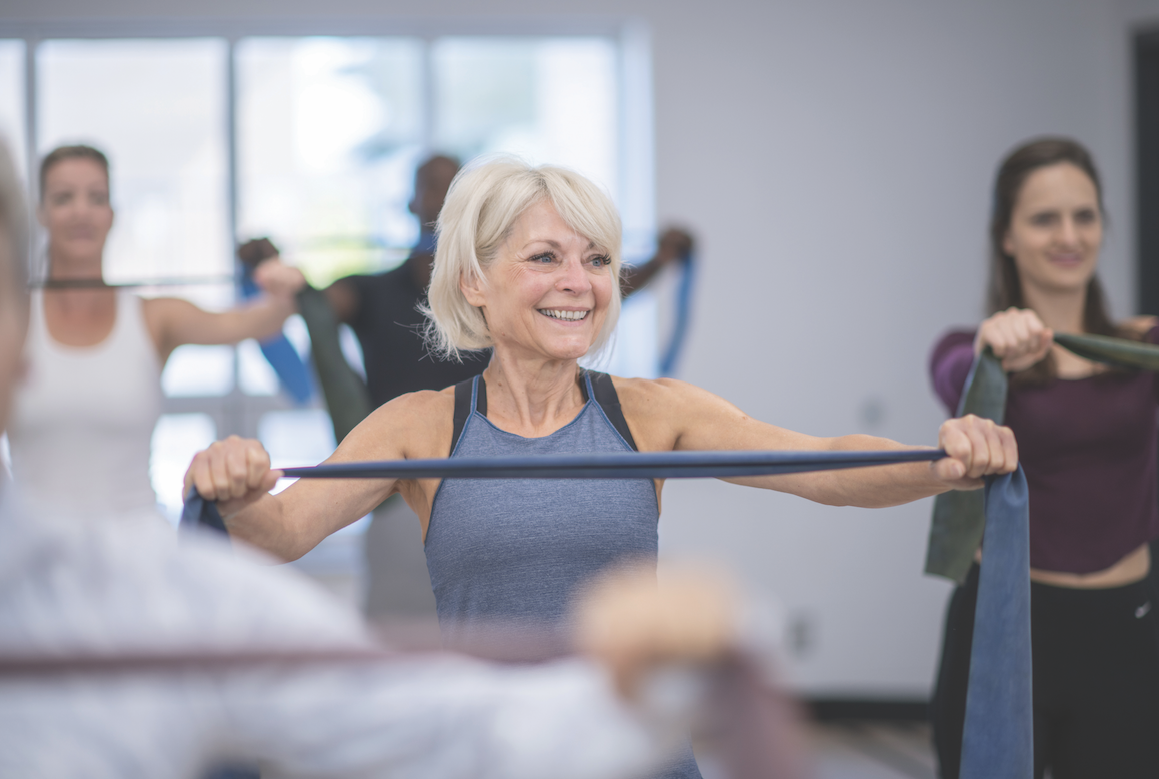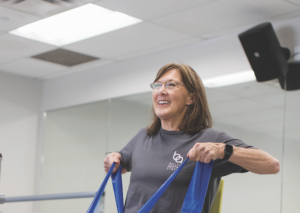You’re Never Too Old to Take a Fitness Class

When Vicki Parsons was in her early 20s, she noticed that she was not leading a very healthy lifestyle and started looking for a change. She thought to herself, “I need to do something. I think I am getting older.” So, she started to be more active throughout her day to put off this ever encroaching “oldness” she felt.
After college, in the mid 1970s, she began working as a recreation therapist — a type of therapist that engages patients in therapeutic, recreation-based activities. In that job, she worked specifically with the elderly population and fell so in love with working with the elderly that she’s been doing it ever since.
While working that first job as a recreation therapist, she noticed that a lot of her patients were really not well, and she wanted to change that.
“I remember thinking that if I could be able to stimulate some sort of joy in everybody’s life every day, [then] that joy might get them up out of their chair, get them moving more, get them more active and get them more social,” Parsons recalls.
Parsons, who calls herself a lifelong mentor at heart, made encouraging people, especially older people, her lifelong passion.
After taking a break from her work to start a family, Parsons began a career with Ballet Austin. At that time, Ballet Austin did not have a lot of programs for adults and instead focused more on children’s ballet.
“When we moved downtown in 2007 and built our new facility,” Parsons explains, “we said, ‘What if we could become a center where all people could be active and be well?’“
So, Parsons decided to bring back some of the things that she used to teach and incorporate them into the new Ballet Austin’s Active Aging Programs. Eleven years ago, Ballet Austin’s first program aimed at an older population began — the Better Balance & Movement Workshop.
“People ask why Ballet Austin is involved in programming for the aging, and I think it goes back to our mission,” Parsons explains. “Our mission statement includes encouraging health and wellbeing. We want to be a catalyst in our community for people of all ages, and we don’t want that to stop when people become a certain age.”

Parsons teaching a class.
Since the first workshop began, the program has been underwritten by AgingWell, a St. David’s Foundation Community Fund program, and the classes are offered to people aged 50+ at no cost.
“It’s wonderful that St. David’s Foundation is committed to this and sees the value of preventative health maintenance and as part of their mission to make it affordable for everybody,” says Katrina Meredith (80), who has been taking Active Aging classes at Ballet Austin for around a year and a half. “The fact that it’s free — I think that is just incredible.”
Now, Ballet Austin offers five different classes as part of their Active Aging Program. They offer an osteo-strong workout that incorporates weight-bearing exercises that are better for bone health; a weights and bands workout for strengthening, toning and cardio; a Feldenkrais method-based movement class; a body and brain boost workshop; and, of course, the balance workshop.
“We may not run five-mile marathons, but there’s a bunch of us out there trying to keep moving,” Meredith says with a laugh.
Meredith, who is an avid walker, joined the program to gain upper-body strength and has definitely noticed an improvement.
“I do the Monday and Thursday classes religiously,” Robyn Jamison (69) says. “I love it because it fulfills a physical health need and because it’s really challenging.”
Jamison first got involved in the Active Aging Program over a year ago through a neighbor of hers and now takes both the osteo-strong class and the weights and bands class. Since starting the classes, she has noticed that her arms have gotten a lot stronger and her posture has greatly improved.
Similar to Jamison, Marsha Hoffer (74) takes both the osteo-strong class and weights and bands class and loves that it keeps her active. Since beginning the classes, she has noticed that her joints, legs, arms and back are not as tight as they previously were.
When talking about the energy of her classes, Parsons recalls an old Garfield cartoon that says, “Well, I am in a bood mood, so I might as well go exercise anyway.” Contrary to Garfield, Parsons wants to make movement fun, easier and something that people will stick with for a little bit longer, and she incorporates all of that into her classes. Because of the way all of her clients rave about her, it’s obvious her techniques work and create an incredible workout environment.
“The time and effort that Vicki has put in to develop the quality of the exercises are really targeting the aging body, so that we don’t do damage and we don’t hurt ourselves,” Meredith says.
In addition to the other classes, Vicki has recently started offering a caregivers workshop that is aimed at empowering caregivers to help prevent falls through information, tips and activities.
“The fear of falling actually creates so many issues — inactivity, social isolation, emotional and mental health issues and so on,” Parsons explains. “I started thinking about the fact that there are family members, friends and actual official caregivers that have a huge opportunity to understand what’s happening with their friend, family member or those they’re caring for, and how they can help them have a better wellness experience.”
Offering the classes virtually has been a great way to create an inclusive and accessible environment, because people from all over the states have been able to tune in and exercise together. Jamison mentions that most of her friends from the class live in different places, like Philadelphia, Washington and Florida.
One idea Parsons lives by and wants to convey to people is that the “aging process” doesn’t begin at a particular age.
“When you’re 22, it’s really hard to imagine what it might be like when you’re 65 or 75,” Parsons says. “Healthy aging doesn’t start when you reach a particular age, and it really starts at birth, and [I wanted to] be able to offer people ways to move and be active throughout life.”
Parsons’ passion for an active lifestyle throughout one’s entire life has carried over greatly into her work through the Active Aging Programs. She loves that she gets to wake up and encourage others to be more active every single day.
“For me, it’s important that people know that there’s an opportunity every single day to be active, to move your body and stay well as long as you can,” Parsons says. “That’s kind of my mantra.”
Five Movements to Do as You Get Older to Promote Active Aging from Vicki Parsons
1. Ankle and calf muscle strengthener (Relevé in ballet)
Besides strengthening the ankles and calf, this is also a great balance exercise. If you can raise your heels at least two inches off the floor, your ankles are quite flexible. Keeping your ankles and calves strong is an important part of balance training. While holding onto a wall, sturdy chair or the kitchen sink, repeatedly raise yourself up and down on tiptoes.
2. Use a resistance band
Besides the physical benefits of using resistance bands, resistance training improves cognitive function in older adults. There are so many exercises you can do with a band, and they can go wherever you go so you can do them anywhere. They are zero impact, so you can get movement in without putting additional strain on your joints. First, you have to buy one. Then, you can google a ton of great uses for the bands.
3. Upper back squeeze
As we get older, we naturally experience weakening in the muscles of the upper back and that affects posture and balance. This is one of my favorites and can be done sitting or standing. Think about trying to hold a pencil between your shoulder blades without dropping it (not possible, but it helps to do this to the fullest). Squeeze your shoulder blades together as tight as you can, hold it to a count of 15 and release. Repeat five times. Do this several times during the day.
4. Adopt this mantra: “Sit less, move more.”
We have to fight this sedentary trend in our country in order to age well. Too much sitting saps energy, makes joints stiff and affects posture and your overall health. You can change that!
5. Take care of your feet and exercise them specifically.
Feet change as we get older but are also vitally important to our overall health and wellbeing — standing, balancing, walking, etc. Each foot is made up of 26 bones, 30 joints, more than 100 muscles, tendons and ligaments and 7,000 nerve endings — all of which work together to provide support, balance and mobility. There is an exercise I like to call toe fists. Open and closing the toes like you would making a fist with the hand. Do this in bed first thing in the morning to wake up those feet, while watching TV or any time sitting in a chair. Those toes are important.






